Metro Stations in Dubai: 2023 Developments and Insights
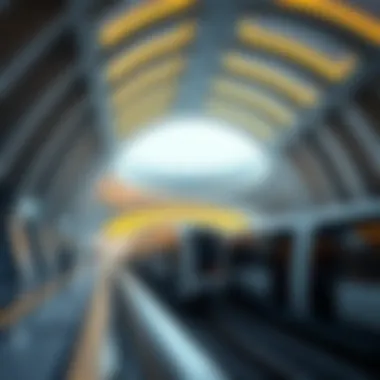
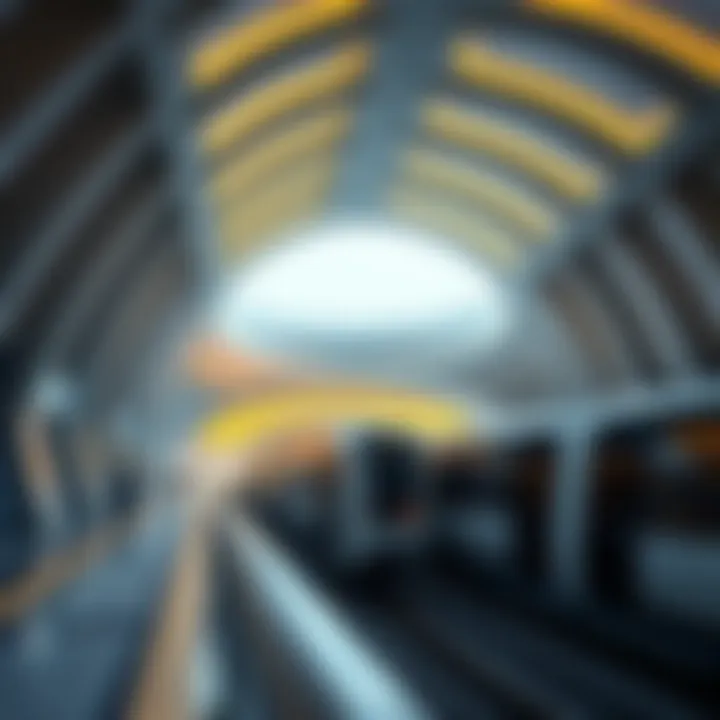
Intro
Dubai’s metro stations have become a backbone of the city’s transport network, offering both residents and tourists a convenient way to navigate the urban sprawl. Since its inception, the Dubai Metro has continually evolved, adapting to the rapid pace of growth that characterizes this modern metropolis.
As we delve into the developments of 2023, it's essential to understand how these stations integrate with the city’s real estate landscape. Metro stations do not just serve as transit hubs; they influence the dynamics of surrounding neighborhoods, enhancing connectivity and accessibility.
In the sections that follow, we will shed light on current trends within the real estate market as it ties into metro stations, explore investment opportunities, and discuss how lifestyle features are being redefined.
By the end, this comprehensive overview will equip investors, homeowners, and expatriates with valuable insight into how the infrastructure evolves alongside urban mobility and residential needs within Dubai.
Intro to Dubai's Metro System in
Dubai's metro system has transformed the urban landscape since its inception, becoming an essential backbone for mobility in this vibrant city. With the development of new stations in 2023, understanding the metro system's evolution and present state provides insights into its role in shaping the bustling metropolis. The metro is more than just a means of transportation; it reflects the growing ambitions of Dubai to promote efficient urban living, reduce traffic congestion, and minimize carbon footprints.
Investment in the metro network illustrates Dubai's commitment to sustainability and innovation. The collaboration of technology and infrastructure in this context is key for preserving the environment while accommodating a growing population. With an extensive network of lines and a range of modern stations, the metro not only facilitates daily commutes but also enhances connectivity across diverse sectors including real estate, tourism, and commerce.
Historical Context of Dubai's Metro Development
When we look back, the inception of the metro system can be traced to the early 2000s when Dubai embarked on a mission to create a modern urban transport network. Significant infrastructure projects were prioritized amidst rapid urbanization — a necessity today. The first line of the metro opened in 2009, marking a pivotal shift in how residents and tourists navigated the city. Its initial goal was to alleviate the ever-growing road traffic, which had started to run amok due to the booming population and increasing vehicle ownership.
The completion of various phases over the years has seen the metro evolve into one of the most advanced and efficient transport systems in the world. Each extension of the metro line, whether it be the Red Line or the Green Line, has been met with community pride and enthusiasm, as passengers welcomed the convenience it brought to their daily lives. Historical factors, such as the influx of expatriates and increased tourism, have all played a role in the ongoing expansion of this vital transit system.
Current State of the Metro System
As of 2023, the Dubai Metro operates two primary lines, comprising a total of 75 kilometers, with more than 50 stations strategically placed to serve the populous areas of the city. The implementation of automated trains and smart ticketing systems has enhanced the efficiency of operations. These developments allow for quicker boarding and smoother transitions, cutting down on wait times and making trips far more pleasant for commuters.
In an era where technology dictates much of urban life, the metro system has integrated many features aimed at improving the rider experience. Real-time updates, digital signage, and mobile applications provide users with indispensable information regarding schedules and travel times. This modernized approach not only increases reliability but fosters a level of confidence among passengers, assuring them that their commute is both safe and enjoyable.
The metro's current capacity can accommodate a staggering number of passengers, reflecting Dubai’s growing reliance on public transport. The system's continuous development highlights a commitment to making mass transit the preferred choice over personal vehicles, which is crucial as the city encourages sustainable practices. In a nutshell, the metro is an indispensable asset that plays a vital role in supporting Dubai's complex urban ecosystem, driving both growth and lifestyle enhancements.
New Metro Stations: Locations and Features
The expansion of Dubai’s metro system isn't just about transportation; it represents a paradigm shift in urban mobility, planning, and infrastructure. As the city continues to grow, the introduction of new metro stations serves as a critical component in shaping how residents and visitors navigate the bustling landscape. Understanding the locations and features of these newly established stations is essential for several reasons: it affects real estate dynamics, community access, and even daily commuting experiences.
When considering the relevance of these new developments, it becomes clear that the locations are strategically chosen. They are not just random spots on a map but rather integral parts of a larger urban framework that aims to enhance connectivity, reduce traffic congestion, and promote sustainability. Additionally, the presence of a metro station often correlates with increased property values in the surrounding areas, making this information valuable for investors and homeowners alike.
Overview of Newly Opened Stations
With the recent opening of several metro stations, Dubai has undeniably transformed its public transport network. One prominent example is the Dubai Marina station, which boasts access to several commercial and residential areas, thereby becoming a vital link in the city's transport matrix. Other significant new stations include Al Karama and Ibn Battuta, both of which cater to high-density neighborhoods, thereby facilitating easier commutes for thousands of residents.
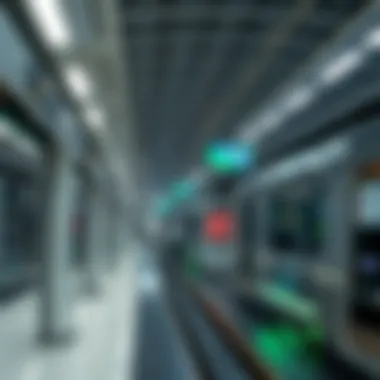

These stations are designed to accommodate a growing population and promote the use of public transit. Each new station is equipped with modern amenities such as electronic ticketing systems, waiting lounges, and even retail spaces, making the commuting experience more comfortable and efficient.
"A metro station isn't just a stop; it's a gateway to opportunities, reshaping urban mobility and community interactions."
Architectural Innovations in Station Design
The architectural designs of the newly opened metro stations reflect a blend of functionality and modern aesthetic sensibility. Each station is not just a station but a landmark that diverges from conventional designs. The stations like Jumeirah Lakes Towers are characterized by their futuristic glass façades and energy-efficient elements, harmonizing with Dubai's ambitious vision of becoming a smart city.
Further design innovations include:
- Sustainable Materials: Utilizing eco-friendly materials reduces environmental impact.
- Enhanced Light Systems: Large windows and innovative lighting technologies create a bright and welcoming atmosphere.
- User-Centric Designs: Axis shifts allow for better flow of foot traffic inside the station, easing congestion especially during peak hours.
The incorporation of art installations also plays a crucial role in the station designs. These artistic features do not only beautify the area but also promote local culture, making each station a reflection of Dubai’s vibrant identity. This thoughtful integration of architecture, function, and local culture ultimately enriches the traveler's experience, ensuring they are part of a thoughtful ecosystem rather than merely commuting from point A to B.
Technological Advancements in Metro Operations
Technological advancements play a crucial role in modernizing Dubai’s metro operations, enhancing both efficiency and passenger experience. In 2023, these advancements are not just about keeping pace with global standards but also about setting new benchmarks in urban transportation. With an emphasis on smart systems, sustainability, and user-friendly experiences, the metro system has evolved into a model of innovation that leverages technology to meet the demands of residents and visitors alike.
Smart Systems and Passenger Experience
The integration of smart systems into the Dubai metro is transforming the way passengers interact with the transportation network. From real-time updates on train schedules to automated ticketing solutions, technology is enhancing the commuter experience significantly.
- Real-Time Tracking: One of the standout features is the mobile app, which allows users to track train locations in real time. No more guessing or waiting in uncertainty; passengers can plan their journeys more efficiently. This feature not only makes commuting easier but also minimizes congestion during peak hours.
- Automated Ticketing: The introduction of smart gates and contactless payment systems has made it easier to access the metro services. Commuters can now use mobile wallets or travel cards to pass through the gates, reducing the time spent in queues and enhancing overall flow.
- Enhanced Safety Features: Technologies such as surveillance cameras and emergency call systems are also in place to ensure passenger safety. With a robust network of cameras, passengers can feel secure while traveling, knowing that their safety is a top priority.
Even smaller innovations, like informative digital displays, help set the stage for a more informed and connected passenger journey. All these elements work together to create a seamless and user-friendly experience that caters to the needs of a diverse population.
Sustainability Initiatives
Sustainability is a buzzword in today’s world, and Dubai's metro system is no exception. In 2023, significant strides have been made towards implementing eco-friendly practices throughout metro operations.
- Energy-Efficient Trains: The trains themselves are designed with energy efficiency in mind. Many of them utilize regenerative braking systems, which recapture energy that would normally be lost during braking, thereby reducing overall energy consumption.
- Solar Power Integration: Stations are embracing renewable energy sources, with many incorporating solar panels that contribute to their energy needs. This not only reduces reliance on non-renewable sources but also aligns with Dubai's broader sustainability goals.
- Recycling and Waste Management: Stations have adopted comprehensive recycling programs to manage waste effectively. The increased focus on reducing waste not only helps in conserving resources but also plays a part in creating a cleaner environment.
"Incorporating technology and sustainability within the metro operations exemplifies how urban transit can lead the way in innovative urban living."
Overall, the technological advancements in metro operations are reshaping public transport in Dubai. By marrying convenience with sustainability, the metro system is not only enhancing commuter experiences but also contributing positively to environmental goals.
Economic Impact of Metro Stations on Surrounding Areas
The economic implications of metro stations in Dubai extend far beyond mere connectivity; they serve as pivotal nodes in the urban landscape, driving growth and transformation in the surrounding areas. As we examine 2023's developments, it becomes clear that these infrastructures provide a multitude of benefits, influencing both the local economy and the real estate market.
Real Estate Trends Near Metro Stations
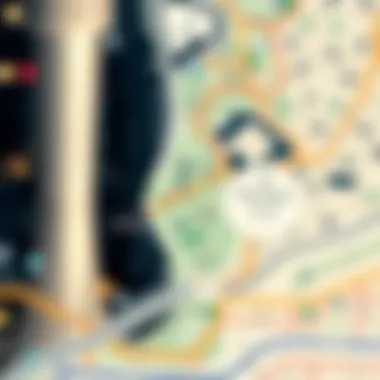

Metro stations have a considerable impact on nearby real estate prices and demand. Research often indicates that properties within close proximity to metro stations tend to experience a surge in value. As Dubai's metro system expands, so does the interest in residential and commercial properties along its routes. In recent years, areas like Dubai Marina and Downtown Dubai, which boast metro access, have observed continued price appreciation and heightened demand. These neighborhoods are not just convenient but also attractive due to their connectivity, transforming once lesser-known districts into vibrant hotspots for both investors and residents.
- Increased Demand: Properties adjacent to metro stations experience an uptick in demand. For instance, recent statistics show that rental prices in the vicinity of metro stations can exceed those in comparable areas by as much as 20%.
- Infrastructural Developments: The presence of a metro station often prompts additional infrastructure improvements, such as roads, parks, and facilities, further enhancing the appeal of these neighborhoods.
- Mixed-Use Developments: Investors are increasingly recognizing the potential of mixed-use developments near metro stations. These projects—combining residential, commercial, and leisure spaces—cater to a diverse audience, aligning with the increasing preference for urban living.
Investment Opportunities Emerging from Metro Proximity
Investors eyeing the Dubai real estate market are keenly aware of the strategic advantages offered by properties near metro stations. The anticipation surrounding future metro expansions and other infrastructural projects often ushers in a wave of investment interest as stakeholders seek to capitalize on the potential for growth.
- Commercial Leasing Opportunities: Metro stations attract foot traffic, making them prime locations for retail spaces. Businesses benefit from exposure to thousands of commuters daily, thereby enhancing their revenue potential.
- Residential Development Projects: With the influx of expatriates and individuals seeking convenience, residential developments near metro stations have become particularly appealing. Providing ease of access to employment hubs or leisure destinations leads to a higher occupancy rate.
- Government Initiatives and Support: The Dubai government’s ongoing commitment to public transport and urban development—backed by substantial investments—provides a solid foundation for properties close to metro stations. Incentives and zoning regulations also favor new projects, making this an opportune time for investors.
"Metro stations do not merely connect locations; they create economic ecosystems that thrive on the flow of people and commerce."
In summary, the economic impact of metro stations in Dubai is profound, fostering growth in both real estate and commercial opportunities. This symbiosis not only enriches the investor landscape but enhances the urban quality of life—making metro-adjacent areas some of the most sought-after in 2023.
Cultural Influence of Metro Stations in Urban Life
The metro stations in Dubai are far from being merely transit points. They serve as vibrant crossroads for diverse communities, enhancing urban life in ways that extend beyond transportation. The metro infrastructure anchors social interaction and fosters a sense of belonging among residents and visitors. Each station is designed not just for functionality but also to echo the culture and history of the area it serves, creating layers of meaning that engage the passengers on their journeys.
Metro Stations as Community Hubs
In the bustling environment of Dubai, metro stations have transformed into community hubs. These venues allow social and cultural exchanges among different demographics. Visitors from various backgrounds converge in these spaces, making them melting pots of ideas, stories, and experiences. Local markets and eateries often spring up nearby, further encouraging social interaction.
Here are some specific ways metro stations act as community hubs:
- Accessibility: Easy access encourages more foot traffic, drawing residents and non-residents alike to explore nearby businesses.
- Events and Gatherings: Stations sometimes host local cultural events or fairs, bringing artists and the public together.
- Networking Opportunities: Commuters may connect over shared journeys, leading to both professional ties and friendships that enrich the community.
One prime example of this phenomenon can be seen at the Dubai Marina station, where the lively atmosphere is palpable with cafes and shops buzzing with life. Passengers often pause to enjoy local cuisine or art displays, rather than rushing to their next destination.
Integration of Art and Culture in Station Designs
The influence of culture extends to the very architecture of the stations. In Dubai, the design of metro stations embodies artistic expressions that reflect the Emirate’s rich heritage and contemporary aspirations. This deliberate integration of art serves several purposes:
- Cultural Symbolism: Each station’s design can include motifs or elements representative of local traditions, which serve to remind residents and visitors of the city’s roots.
- Visual Engagement: The creative use of colors, sculptures, and murals can enhance the aesthetic experience of travelers, transforming an ordinary commute into a journey through art.
- Public Art Projects: Some stations collaborate with local artists to exhibit artworks, giving them a platform while enriching the station’s ambiance.
For instance, the Aladdin station features intricate designs inspired by traditional Islamic art, transporting travelers to a realm of cultural appreciation even before they step out for their day.
In summary, metro stations in Dubai are vital to the city’s urban ecosystem. They serve not only as functional transport links but as cultural landmarks that shape social interactions and foster community engagement. As the metropolis continues to evolve, the role of these stations will likely grow, making them even more central to the vibrant tapestry of Dubai's urban life.
Future Projections for Dubai's Metro System
The future of Dubai's Metro system holds significant importance, shaping not only the daily commute for countless individuals but also impacting the very fabric of urban development in this rapidly growing city. With ambitious plans in place, understanding the upcoming changes can provide invaluable insights for investors, homeowners, and expatriates looking to immerse themselves in this dynamic environment. The integration of advanced technology and expanded routes directly contributes to Dubai's commitment to becoming a smart city, fostering a seamless blend of innovation and sustainability.
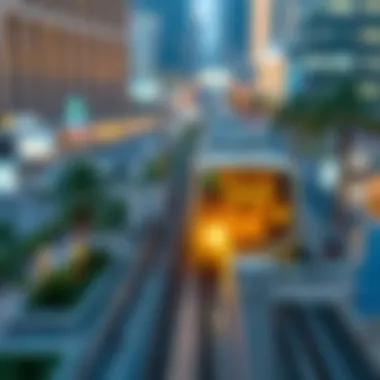

Planned Extensions and New Routes
Dubai's Metro is set for a transformative phase with several proposed extensions and new routes on the horizon. These developments aim to cater to the increasing demand for efficient public transport, enhance connectivity, and ease traffic congestion.
- Al Maktoum International Airport Extension: An extension is planned to connect the metro directly to Al Maktoum International Airport, making it easier for travelers to access the airport via public transport. This will likely increase passenger convenience and boost tourism.
- Route 2020: A recent addition, Route 2020 extends the Red Line, linking the metro to the Expo 2020 site and beyond. This route opens new avenues for residents and tourists alike, enhancing their access to key sites across the city.
- Green Line Expansion: There are aspirations to extend the Green Line towards Dubai Marina, effectively linking areas often frequented by residents and tourists. This extension can significantly reduce commute times for those living or working in those areas.
- Strategic Accessibility: The new routes are strategically designed to link key residential and commercial hubs, including Dubai Silicon Oasis and other developing neighborhoods, which will encourage growth and investment in these regions.
These extensions promise to enhance the overall user experience while reinforcing the need for an efficient and effective public transport system in one of the busiest cities in the world.
Potential Challenges Ahead
While the future of Dubai Metro looks promising, there are several challenges that stakeholders need to address to ensure these plans come to fruition.
- Funding and Investment: Securing sufficient funding for expansive projects poses a considerable challenge. Ensuring consistent investment will be necessary to complete planned extensions successfully. Investors interested in real estate should keep a watchful eye on government and private sector initiatives to support this expansion.
- Urban Infrastructure: As the metro is expanded, existing urban infrastructure might need significant upgrades. Integrating new stations into the current transport system requires careful planning to avoid disruptions in services and traffic flows.
- Public Acceptance and Usage: Encouraging public adoption can be tricky. Number of people who need to feel comfortable with the new connections; making sure services are reliable, and safe is key. Effective marketing strategies and community engagement initiatives are essential to boost ridership.
- Environmental Considerations: Any infrastructure project must consider environmental sustainability. With increasing population density, construction may affect local ecosystems. Addressing these concerns early on is crucial.
The future developments in Dubai's Metro system not only underline the government’s ambitions for rapid urban transformation but also present unique opportunities and challenges for all stakeholders involved.
In summary, keeping abreast of these planned extensions and potential challenges can provide essential insights for those engaged in the real estate or investment landscape of Dubai. As the city continues to evolve, so does the importance of its metro system in shaping a more accessible and connected urban environment.
Culmination: The Role of Metro Stations in Dubai's Urban Ecosystem
Dubai's metro system acts as a lifeblood, interlinking neighborhoods with their own unique vibrancy. In 2023, the metro stands as more than a mere public transport system; it’s a fundamental part of Dubai’s urban structure and a catalyst for socioeconomic advancement. The efficient transport system both reduces congestion on the roads and fuels economic activity, directly influencing the real estate market and urban development across the emirate.
Metro stations serve as pillars of connectivity, allowing easy access to key commercial, residential, and cultural areas. As commuters speed through the city, they engage with the urban landscape in a way that would be tedious or impossible by car. This accessibility fosters a more active lifestyle, encouraging residents and expats alike to explore neighborhoods, shop, dine, and engage in community activities. The surge of foot traffic often prompts businesses to flourish, creating a symbiotic relationship between metro stations and local economies.
Moreover, these stations are not merely functional; they offer design and art that reflect Dubai’s diverse culture. From intricate tile work to dynamic light displays, the aesthetics of metro stations invite conversations and admiration. Thus, they transform daily commutes into an experiential journey, enriching the lives of those who use them.
What’s particularly striking is the sustainability angle. With the increasing emphasis on eco-friendly transportation, metro systems play a crucial role in reducing the city’s carbon footprint. They contribute to cleaner air and alleviate road congestion, questions that have been on the minds of policymakers and residents alike. Aligning with Dubai’s vision for a sustainable city, the metro is at the forefront of these initiatives, showcasing innovations that pave the way for greener urban living.
In a nutshell, metro stations in Dubai are not just stops along a route; they are
- Economic drivers, influencing real estate and local businesses.
- Cultural amalgamators, showcasing art and community.
- Sustainability champions, reducing environmental impact.
As investment opportunities burgeon around metro lines, understanding their significance becomes critical for investors and homeowners. In this light, the metro emerges not merely as transit but as a dynamic element in shaping Dubai’s urban ecosystem—a crucial aspect that resonates through its streets, structures, and society at large.
"The metro's impact is felt far beyond its tracks; it bridges communities and embraces the future of urban living."
Recap of Key Insights
In reviewing our exploration of the metro stations, several points emerge:
- Historical Progression: The metro's evolution from conception to operational powerhouse reflects Dubai's rapid urbanization and ambition.
- New Developments: Recent station openings highlight modern architectural design and efficient layout, catering to the growing population.
- Technological Integration: Innovations enhance passenger experience, making commuting not just easier but also safer and more efficient.
- Economic Growth: The correlation between metro access and rising property values indicates strong investment potential for buyers and developers.
- Cultural Aspects: Stations that feature local art and design foster a sense of identity and pride among residents.
- Environmental Commitment: The shift toward sustainability is a major focus, with ongoing efforts to minimize ecological footprints.
Final Thoughts on Metro's Impact
The implications of the metro system in Dubai extend into various aspects of urban life, touching on economic, social, and environmental spheres. Investors looking to capitalize on opportunities must recognize the metro's pivotal role in shaping neighborhoods and boosting the local economy.
As Dubai continues to expand and evolve, its metro stations will remain vital in connecting people, fostering community engagement, and supporting the sustainability initiatives that define the emirate’s future. For homeowners and expatriates, proximity to these transport hubs means more than convenience; it signifies an investment in the heart of a thriving metropolitan landscape—a neighborhood that can adapt, grow, and thrive in harmony with the rhythm of this great city.















